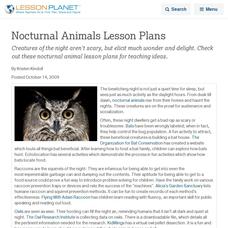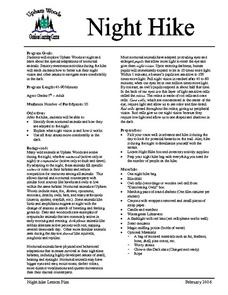Curated OER
Come to Mommy
Fourth graders participate in a simple experiment to illustrate the concept of mother bats identifying their young. They sniff stickers in order to imitate the behavior of mother bats in the wild.
Curated OER
Nocturnal Animals Lesson Plans
Creatures of the night aren't scary, but elicit much wonder and delight. Check out these nocturnal animal lesson plans for teaching ideas.
Curated OER
Echo Location
Students participate in a role-playing activity that demonstrates how whales use sound as an adaptation to their environment.
Curated OER
Nocturnal Animals
For this animal worksheet, students complete a cloze activity about nocturnal animals by filling in the blanks in 2 paragraphs using 9 words from a word bank. They color and cut out 13 small pictures of nocturnal animals and paste them...
Curated OER
Nocturnal Animals Cloze Activity
In this science cloze activity, 3rd graders fill in the 9 blanks in a selection about nocturnal animals. They use the words from a word bank at the bottom of the page to complete the paragraph. They cut out pictures of nocturnal animals...
Curated OER
Dolphin Dive
In this reading worksheet, students complete several paragraphs about dolphins by filling in the word that best completes the sentence. Thirteen words are included to complete the paragraphs.
Curated OER
What Shape Is It?
Young scholars predict the shape of an unknown object by bouncing a ball on it. In this physics lesson, students relate this activity to how dolphins use echo-location to navigate. They analyze their lab result and discuss findings.
Curated OER
Night Hike
Students explore Upham Woods at night and investigate about the special adaptations of nocturnal animals. They identify three nocturnal animals and how they are adapted to the night. Students explain what night vision is and how it works.
Curated OER
Mammals Crossword
In this mammals worksheet, students complete a crossword puzzle with 37 questions about characteristics, behavior and types of mammals.
Other
Bats4 Kids: Bats, Bats, Everywhere
Bat Conservation International has 24 biologists, educators, and administrators who are dedicated to their mission to further education, research, and conservation of bats. Dr. Merlin Tuttle and his staff have constructed Bats4Kids to...
Library of Congress
Loc: Everyday Mysteries: Why Do Bats Live in Caves?
Ever wonder why bats live in caves? Or why bats don't fly into objects at night? This article describe why bats thrive in the protected shelter a cave provides. It also explains how bats use echolocation to locate food and avoid obstacles.
Science Buddies
Science Buddies: Bat Detector: Listen to the Secret Sounds of Bats
Sometimes bats can "whoosh" right by you, and not be seen. In this science fair project, you will be able to detect flying bats by listening in on the ultrasonic signals they produce to locate objects in their environment. The bat...
Scientific American
Scientific American: A Field Guide to Bats : In Depth Reports
Uncover the evolutionary past of the mysterious bats. Find out about their amazing ability to use sonar, the threat of rabies they carry, and conservation efforts to save the species.
PBS
Pbs Teachers: Scientific American: Calls of the Wild: Bats and Echolocation
Explore bats' navigation systems by experimenting with echolocation. Approximate an object's distance by analyzing reflected sound waves, measuring the delay in sound and calculating the ratio to the speed of sound.
Read Works
Read Works: Bat News
[Free Registration/Login Required] This nonfiction passage describes the job of a chiroptologist, a bat scientist. This passage reinforces essential reading comprehension skills. Opportunities for vocabulary acquisition are also...
TeachEngineering
Teach Engineering: Biomimicry: Echolocation in Robotics
Students use ultrasonic sensors and LEGO MINDSTORMS NXT robots to emulate how bats use echolocation to detect obstacles. They measure the robot's reaction times as it senses objects at two distances and with different sensor threshold...
Unite for Literacy
Unite for Literacy: Mystic Aquarium: Bats Dare to Be Different
Read about bats' characteristics, habitat, diet, behavior, and their unique hearing ability called echolocation. You'll also learn why they are important to humans, the threats they face, and what you can do to help them. Includes audio...
Natural History Museum
Natural History Museum: The Secret Life of Bats: Bat Senses
Part of an online exhibit on bats, this section focuses on bat senses: sight, olfaction (smell), echolocation, and hearing.
Other
Contra Costa County Office of Education: Bats: Why Should You Care?
At this site, provided by the Contra Costa County Office of Education, you can get the facts on bats and their environment.
National Geographic Kids
National Geographic Kids: Animals: Vampire Bats
Great multi-media site from the National Geographic Society with great information, pictures and video of Vampire Bats. Sections include fun facts, video, audio, a map and send a postcard.
PBS
Idaho Public Education: Bats
Explore this site to understand facts and general information about bats. Learn about bat wings and houses, why they hang upside down, echolation, and more! Classroom activities and games are also included.
Read Works
Read Works: A Real Life Bat Man
[Free Registration/Login Required] This passage describes the responsibilities of a chiroptologist, a person who studies bats for a living. This passage is a stand-alone curricular piece that reinforces essential reading skills and...
PBS
Pbs Teachers:borneo: A Batty Mapping Method
Explore how bats use echolocation to find prey by using echoes to map the direction and distance to various echo sources in their surroundings. Determine the minimum distance at which an echo can be heard and the distance to an echo source.






















